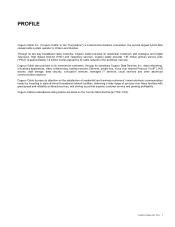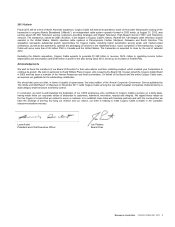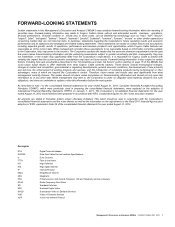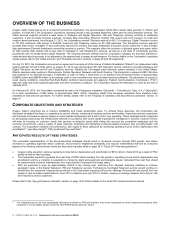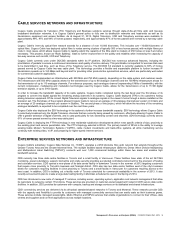Cogeco 2012 Annual Report Download - page 12
Download and view the complete annual report
Please find page 12 of the 2012 Cogeco annual report below. You can navigate through the pages in the report by either clicking on the pages listed below, or by using the keyword search tool below to find specific information within the annual report.Management’s Discussion and Analysis (MD&A) COGECO CABLE INC. 2012 11
PSU GROWTH AND PENETRATION OF SERVICE OFFERINGS
As of fiscal 2012, Cogeco Cable has modified its key performance indicator for growth to a PSU concept instead of a revenue-generating units
(“RGU”) concept. PSU expansion is an important driver of revenue growth and measures the success of the marketing strategy and the
competitiveness of the service offerings and pricing. For the 2012 fiscal year, as revised on July 11, 2012, Cogeco Cable’s projected growth of
72,000 PSU, which was achieved with 71,664 PSU as a result of targeted marketing initiatives and the continuing interest for HD television
service. Penetration statistics measure Cogeco Cable’s market share. Cogeco Cable computes the penetration for all its services as a
percentage of homes passed. For further details please consult the customer statistics on the “Cable services” section on page 29.
CRITICAL ACCOUNTING POLICIES AND ESTIMATES
Preparation of the consolidated financial statements in accordance with IFRS requires management to adopt accounting policies and to make
estimates and assumptions that affect the reported amounts of assets and liabilities, contingent assets and liabilities and revenue and
expenses during the reporting year. A summary of the Corporation’s significant accounting policies is presented in note 2 of the consolidated
financial statements. The following accounting policies were identified as critical to Cogeco Cable’s business operations.
REVENUE RECOGNITION
Revenue is measured at the fair value of the consideration received or receivable, net of returns and discounts. The Corporation recognizes
revenue from the sale of products or the rendering of services when the following conditions are met:
The amount of revenue and related costs can be measured reliably;
The significant risks and rewards of ownership have been transferred to customers and there is no continuing management
involvement with the goods; and
The recovery of the consideration is probable.
More specifically, the Corporation’s principal sources of revenue are recognized as follows:
Monthly subscription revenue received for Cable Television, HSI and Telephony services and rental of equipment are recognized as
the services are provided;
Revenue from data services, long-distance and other pay-per-use services are recorded as the services are provided;
Revenue from managed services, Internet connectivity, dark fibre services and other advance communication solutions are recorded
as the services are provided; and
Revenue generated from the sale of home terminal devices or other equipment are recorded when the equipment is delivered and
accepted by the customers.
ALLOWANCE FOR DOUBTFUL ACCOUNTS
Allowance for doubtful accounts is established based on specific credit risk of the Corporation’s customers by examining such factors as the
number of overdue days of the customer’s balance outstanding as well as the customer’s collection history. As a result, conditions causing
fluctuations in the aging of customer accounts will directly impact the reported amount of bad debt expenses.
BUSINESS COMBINATIONS
Fair value of assets acquired and liabilities assumed in a business combination is estimated based on information available at date of
acquisition and involves considerable judgement in determining the fair values assigned to the property, plant and equipment and intangible
assets acquired and liabilities assumed on acquisition. Among other things, the determination of these fair values involves the use of
discounted cash flow analyses, estimated future margins and estimated future customer counts.
CAPITALIZATION OF PROPERTY, PLANT AND EQUIPMENT
During construction of new assets, direct costs plus overhead costs directly attributable to the asset are capitalized. Borrowing costs directly
attributable to the acquisition or construction of qualifying assets, which require a substantial amount of time to get ready for their intended use
or sale, are capitalized until such time the assets are substantially ready for their intended use or sale. All other borrowing costs are recorded
as financial expense in the period in which they are incurred.
CAPITALIZATION OF INTANGIBLE ASSETS
Reconnect and additional service activation costs are capitalized up to a maximum amount not exceeding the revenue generated by the
reconnect activity. Direct and incremental costs associated with the acquisition of Enterprise services customers are capitalized.


